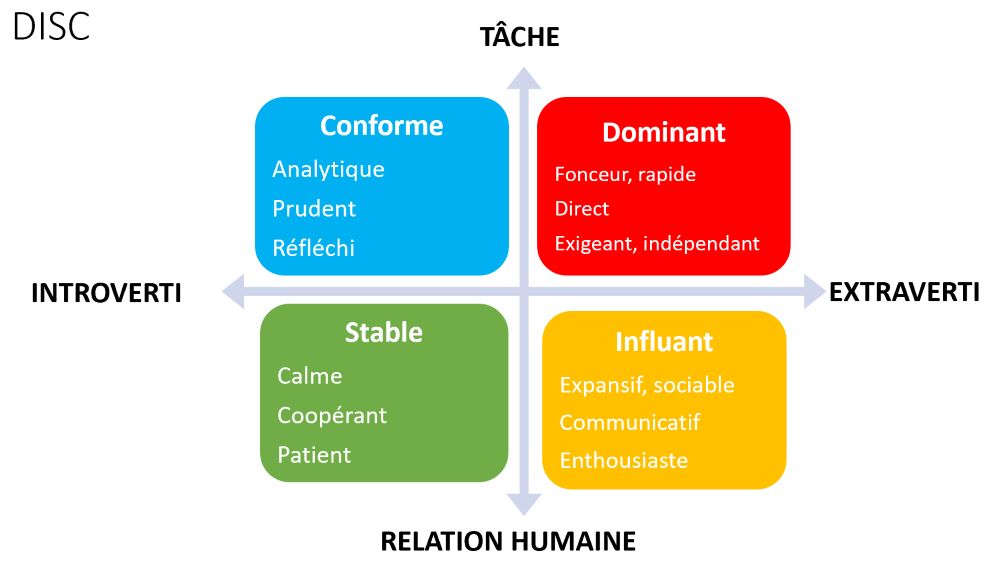DISC sales method
The DISC sales technique has been very popular in recent years, and is based on the analysis of customer profiles in order to optimize communication and persuasion. Principles of the DISC sales method The technique is a psychological analysis of the customer: From this, we determine four types of buyer to whom we address ourselves […]
The DISC sales technique has been very popular in recent years, and is based on the analysis of customer profiles in order to optimize communication and persuasion.
Principles of the DISC sales method

The technique is a psychological analysis of the customer:
- Task orientation or human orientation, these are the two dimensions of the model developed by Blake and Mouton, American work psychologists who developed a model for evaluating managers in the 60s and 70s.
- Introversion or extraversion, both dimensions of which are also found in the Myers Briggs psychological test.
From this, we determine four types of buyer to whom we address ourselves in different ways.
Dominant buyer type (red)
This buyer is task-oriented, doesn’t waste time talking about everything and anything, and doesn’t try to please the other person – he wants to achieve his goals.
He’s also an extrovert, so he’ll tell you directly whether he likes it or not, and he won’t hesitate to voice his objections and tell you he’ll buy if he sees the point.
So don’t waste time talking to him about anything and everything, but get straight to the point and show him how you’re going to help him achieve his goals.
The red is a dominator, he trusts his intuition, doesn’t waste time, if he’s convinced he’ll buy quickly, because he has other things to do. This is the most common type of business start-up.
Type of influential buyer (yellow)
This buyer is extroverted like the dominant, but is people-oriented, friendly, interested in you, tries to put you at ease, likes to discuss subjects not directly related to work.
You need to take your time, listen to him, and talk about the subjects he likes – family, sports, vacations, current affairs – according to his preferences.
He’ll buy because he likes the relationship you’ve developed with him, and then it’ll be hard for competitors to take your place, because he won’t want to jeopardize your relationship.
Stable (green)
The stable is the opposite of the dominant, introverted and relationship-oriented, it’s a pleasant person who talks little, listens, asks questions, takes its time to make decisions and put you at ease.
You need to take your time to maintain a warm and cordial relationship with him, while reassuring him with figures, studies and tests. He’ll be happy to familiarize himself with your solution.
Compliance (blue)
The conformist is introverted and task-oriented. Often insecure and fussy, it’s not the most pleasant of interlocutors, especially for red-style salespeople.
He needs figures, studies, Excel tables, he takes his time, asks questions, checks, goes into detail.
You need to reassure him by answering his questions, give him time, details, figures and tables, and avoid going off topic.
The advantages of the DISC method
The main advantage is to avoid the wrong type of communication, and to adapt to the profile of your interlocutor, to meet his or her expectations.
This method is well suited to regular sales, where you get to know your customer very well.
The method is also useful when selling complex products to a team. For example, you can identify the company director as red, the specifier as yellow and the buyer as blue, then adapt your communication to each of the players.
Disadvantages of the DISC method
The difficulties are as follows:
- Discovering motivations is often easier with SONCAS, especially if you don’t know the customer.
- In terms of psychology, it’s limiting to try to fit all people into just four boxes.
- To sell effectively, you also need to use persuasion techniques such as SPIN or SOS.
Conclusion
The method is popular, and we all know personalities who fit perfectly into the four personality types, but you need to complement the DISC method with sales steps and persuasion techniques.
Jean-Pierre Mercier
